ACCT2004 Assignment 1: Auditing, Materiality, and Ethical Issues
VerifiedAdded on 2023/03/20
|13
|4211
|98
Homework Assignment
AI Summary
This assignment solution for ACCT2004, Auditing and Internal Controls, addresses key aspects of auditing. Question 1 analyzes inherent risks at MaxSecurity Limited, a manufacturer facing industry-specific risks like sensitive product designs and complex costing. It also discusses factors in determining preliminary materiality. Question 2 examines debtor confirmations as audit evidence, including strengths, weaknesses, and whether they can be used alone. The analysis considers the case of Shady Oaks Hospital and its accounts receivable. Question 3 covers ethical issues faced by Meg, compliance with APES 110, available audit report options, and recommendations. The solution provides a thorough examination of auditing principles and their practical application in a real-world scenario, incorporating relevant auditing standards and providing actionable insights for auditors.
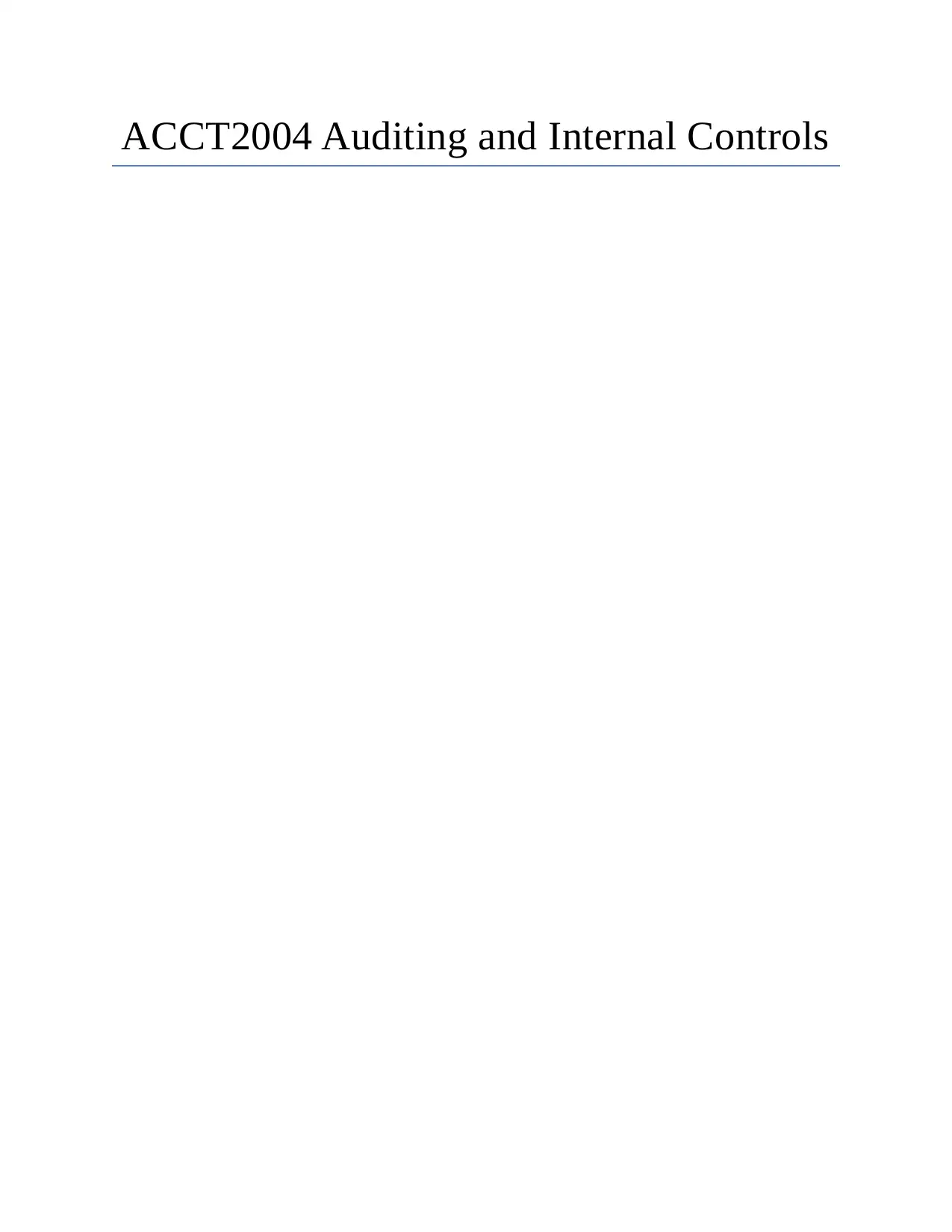
ACCT2004 Auditing and Internal Controls
Paraphrase This Document
Need a fresh take? Get an instant paraphrase of this document with our AI Paraphraser
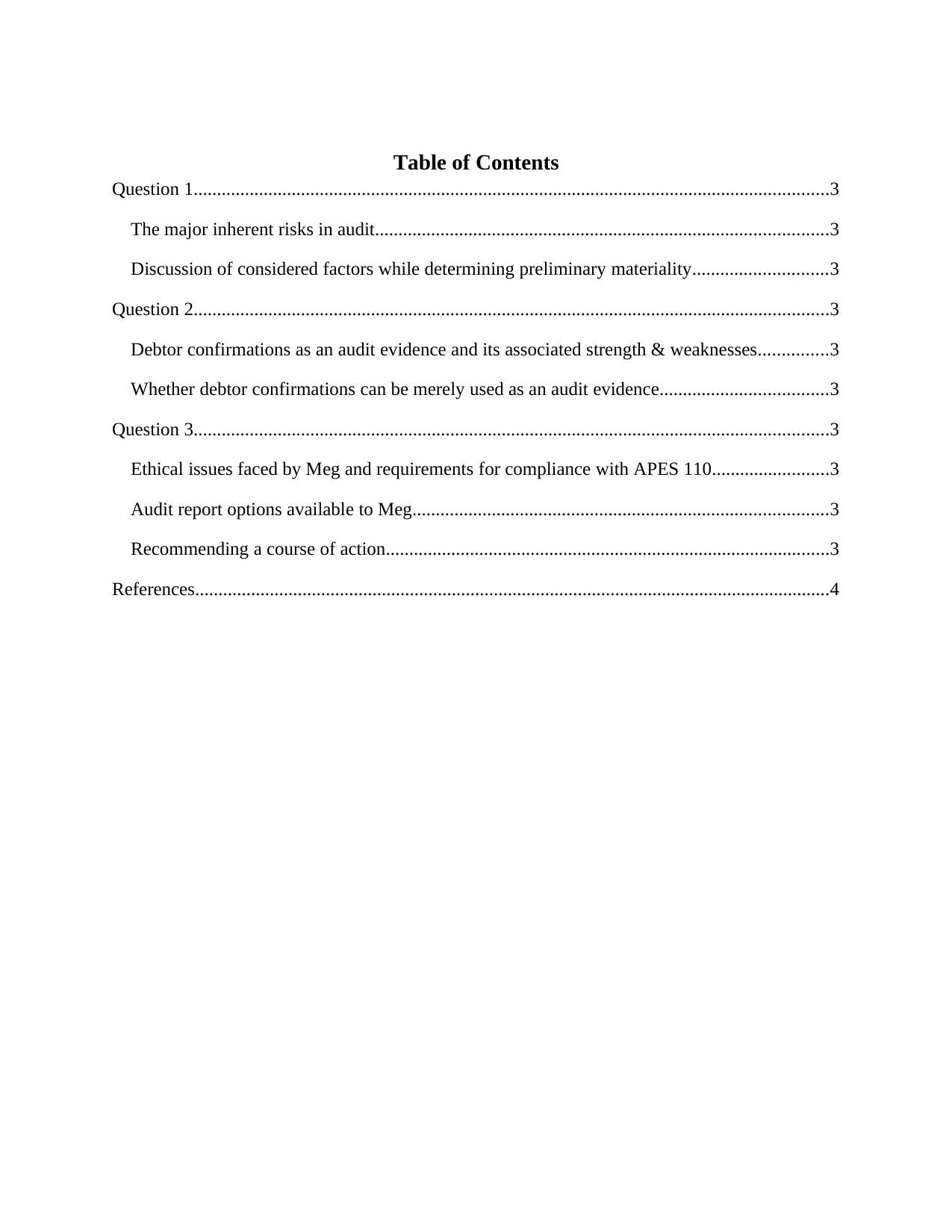
Table of Contents
Question 1........................................................................................................................................3
The major inherent risks in audit.................................................................................................3
Discussion of considered factors while determining preliminary materiality.............................3
Question 2........................................................................................................................................3
Debtor confirmations as an audit evidence and its associated strength & weaknesses...............3
Whether debtor confirmations can be merely used as an audit evidence....................................3
Question 3........................................................................................................................................3
Ethical issues faced by Meg and requirements for compliance with APES 110.........................3
Audit report options available to Meg.........................................................................................3
Recommending a course of action...............................................................................................3
References........................................................................................................................................4
Question 1........................................................................................................................................3
The major inherent risks in audit.................................................................................................3
Discussion of considered factors while determining preliminary materiality.............................3
Question 2........................................................................................................................................3
Debtor confirmations as an audit evidence and its associated strength & weaknesses...............3
Whether debtor confirmations can be merely used as an audit evidence....................................3
Question 3........................................................................................................................................3
Ethical issues faced by Meg and requirements for compliance with APES 110.........................3
Audit report options available to Meg.........................................................................................3
Recommending a course of action...............................................................................................3
References........................................................................................................................................4
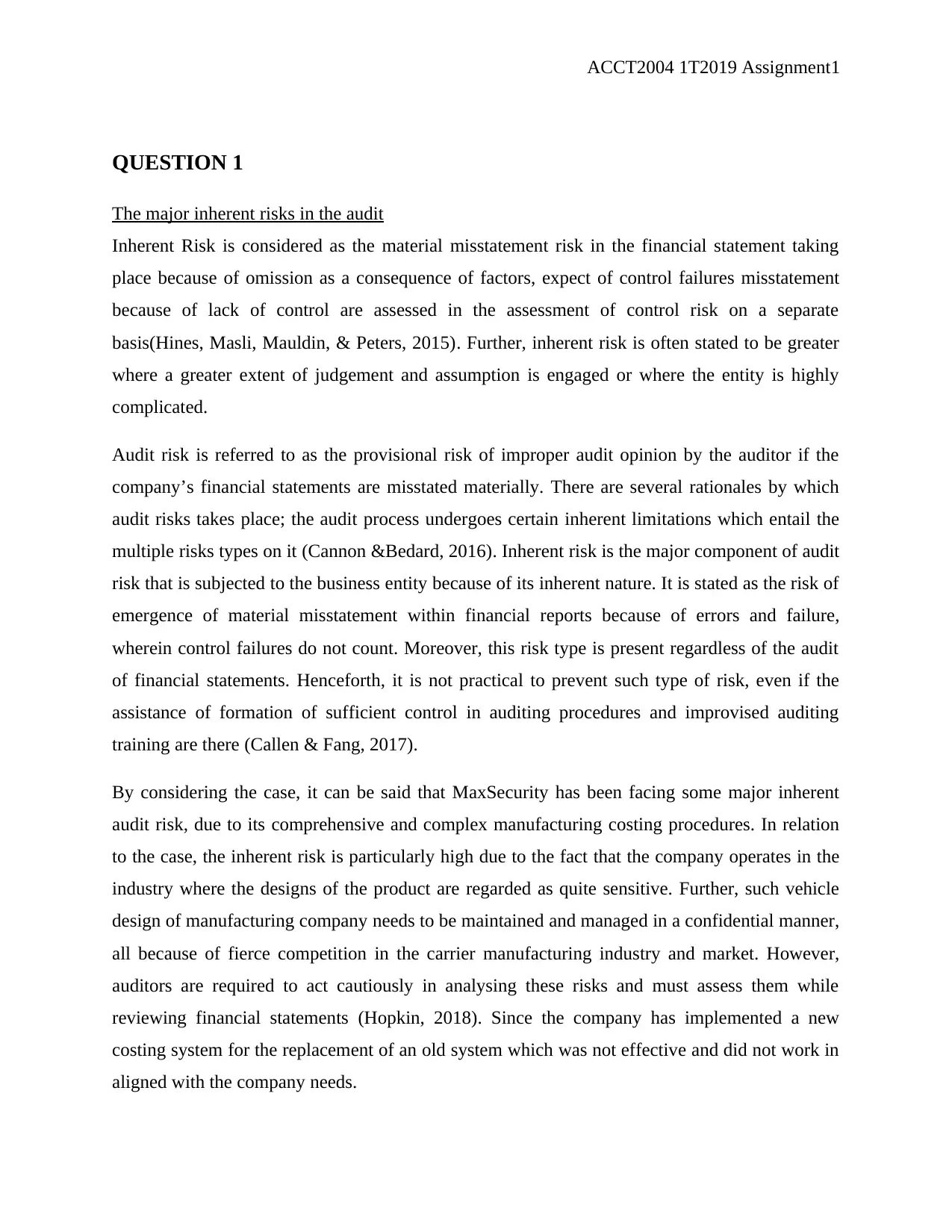
ACCT2004 1T2019 Assignment1
QUESTION 1
The major inherent risks in the audit
Inherent Risk is considered as the material misstatement risk in the financial statement taking
place because of omission as a consequence of factors, expect of control failures misstatement
because of lack of control are assessed in the assessment of control risk on a separate
basis(Hines, Masli, Mauldin, & Peters, 2015). Further, inherent risk is often stated to be greater
where a greater extent of judgement and assumption is engaged or where the entity is highly
complicated.
Audit risk is referred to as the provisional risk of improper audit opinion by the auditor if the
company’s financial statements are misstated materially. There are several rationales by which
audit risks takes place; the audit process undergoes certain inherent limitations which entail the
multiple risks types on it (Cannon &Bedard, 2016). Inherent risk is the major component of audit
risk that is subjected to the business entity because of its inherent nature. It is stated as the risk of
emergence of material misstatement within financial reports because of errors and failure,
wherein control failures do not count. Moreover, this risk type is present regardless of the audit
of financial statements. Henceforth, it is not practical to prevent such type of risk, even if the
assistance of formation of sufficient control in auditing procedures and improvised auditing
training are there (Callen & Fang, 2017).
By considering the case, it can be said that MaxSecurity has been facing some major inherent
audit risk, due to its comprehensive and complex manufacturing costing procedures. In relation
to the case, the inherent risk is particularly high due to the fact that the company operates in the
industry where the designs of the product are regarded as quite sensitive. Further, such vehicle
design of manufacturing company needs to be maintained and managed in a confidential manner,
all because of fierce competition in the carrier manufacturing industry and market. However,
auditors are required to act cautiously in analysing these risks and must assess them while
reviewing financial statements (Hopkin, 2018). Since the company has implemented a new
costing system for the replacement of an old system which was not effective and did not work in
aligned with the company needs.
QUESTION 1
The major inherent risks in the audit
Inherent Risk is considered as the material misstatement risk in the financial statement taking
place because of omission as a consequence of factors, expect of control failures misstatement
because of lack of control are assessed in the assessment of control risk on a separate
basis(Hines, Masli, Mauldin, & Peters, 2015). Further, inherent risk is often stated to be greater
where a greater extent of judgement and assumption is engaged or where the entity is highly
complicated.
Audit risk is referred to as the provisional risk of improper audit opinion by the auditor if the
company’s financial statements are misstated materially. There are several rationales by which
audit risks takes place; the audit process undergoes certain inherent limitations which entail the
multiple risks types on it (Cannon &Bedard, 2016). Inherent risk is the major component of audit
risk that is subjected to the business entity because of its inherent nature. It is stated as the risk of
emergence of material misstatement within financial reports because of errors and failure,
wherein control failures do not count. Moreover, this risk type is present regardless of the audit
of financial statements. Henceforth, it is not practical to prevent such type of risk, even if the
assistance of formation of sufficient control in auditing procedures and improvised auditing
training are there (Callen & Fang, 2017).
By considering the case, it can be said that MaxSecurity has been facing some major inherent
audit risk, due to its comprehensive and complex manufacturing costing procedures. In relation
to the case, the inherent risk is particularly high due to the fact that the company operates in the
industry where the designs of the product are regarded as quite sensitive. Further, such vehicle
design of manufacturing company needs to be maintained and managed in a confidential manner,
all because of fierce competition in the carrier manufacturing industry and market. However,
auditors are required to act cautiously in analysing these risks and must assess them while
reviewing financial statements (Hopkin, 2018). Since the company has implemented a new
costing system for the replacement of an old system which was not effective and did not work in
aligned with the company needs.
⊘ This is a preview!⊘
Do you want full access?
Subscribe today to unlock all pages.

Trusted by 1+ million students worldwide
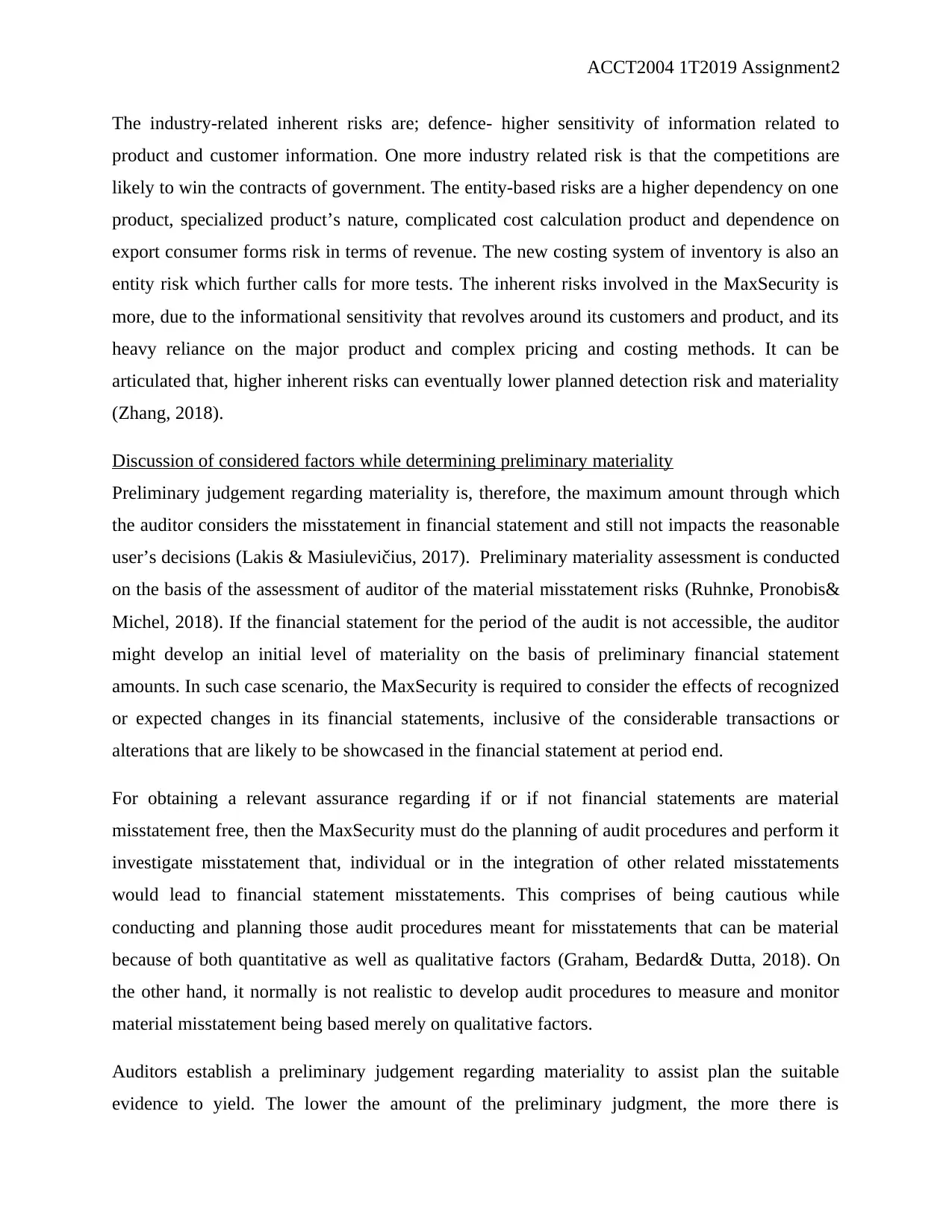
ACCT2004 1T2019 Assignment2
The industry-related inherent risks are; defence- higher sensitivity of information related to
product and customer information. One more industry related risk is that the competitions are
likely to win the contracts of government. The entity-based risks are a higher dependency on one
product, specialized product’s nature, complicated cost calculation product and dependence on
export consumer forms risk in terms of revenue. The new costing system of inventory is also an
entity risk which further calls for more tests. The inherent risks involved in the MaxSecurity is
more, due to the informational sensitivity that revolves around its customers and product, and its
heavy reliance on the major product and complex pricing and costing methods. It can be
articulated that, higher inherent risks can eventually lower planned detection risk and materiality
(Zhang, 2018).
Discussion of considered factors while determining preliminary materiality
Preliminary judgement regarding materiality is, therefore, the maximum amount through which
the auditor considers the misstatement in financial statement and still not impacts the reasonable
user’s decisions (Lakis & Masiulevičius, 2017). Preliminary materiality assessment is conducted
on the basis of the assessment of auditor of the material misstatement risks (Ruhnke, Pronobis&
Michel, 2018). If the financial statement for the period of the audit is not accessible, the auditor
might develop an initial level of materiality on the basis of preliminary financial statement
amounts. In such case scenario, the MaxSecurity is required to consider the effects of recognized
or expected changes in its financial statements, inclusive of the considerable transactions or
alterations that are likely to be showcased in the financial statement at period end.
For obtaining a relevant assurance regarding if or if not financial statements are material
misstatement free, then the MaxSecurity must do the planning of audit procedures and perform it
investigate misstatement that, individual or in the integration of other related misstatements
would lead to financial statement misstatements. This comprises of being cautious while
conducting and planning those audit procedures meant for misstatements that can be material
because of both quantitative as well as qualitative factors (Graham, Bedard& Dutta, 2018). On
the other hand, it normally is not realistic to develop audit procedures to measure and monitor
material misstatement being based merely on qualitative factors.
Auditors establish a preliminary judgement regarding materiality to assist plan the suitable
evidence to yield. The lower the amount of the preliminary judgment, the more there is
The industry-related inherent risks are; defence- higher sensitivity of information related to
product and customer information. One more industry related risk is that the competitions are
likely to win the contracts of government. The entity-based risks are a higher dependency on one
product, specialized product’s nature, complicated cost calculation product and dependence on
export consumer forms risk in terms of revenue. The new costing system of inventory is also an
entity risk which further calls for more tests. The inherent risks involved in the MaxSecurity is
more, due to the informational sensitivity that revolves around its customers and product, and its
heavy reliance on the major product and complex pricing and costing methods. It can be
articulated that, higher inherent risks can eventually lower planned detection risk and materiality
(Zhang, 2018).
Discussion of considered factors while determining preliminary materiality
Preliminary judgement regarding materiality is, therefore, the maximum amount through which
the auditor considers the misstatement in financial statement and still not impacts the reasonable
user’s decisions (Lakis & Masiulevičius, 2017). Preliminary materiality assessment is conducted
on the basis of the assessment of auditor of the material misstatement risks (Ruhnke, Pronobis&
Michel, 2018). If the financial statement for the period of the audit is not accessible, the auditor
might develop an initial level of materiality on the basis of preliminary financial statement
amounts. In such case scenario, the MaxSecurity is required to consider the effects of recognized
or expected changes in its financial statements, inclusive of the considerable transactions or
alterations that are likely to be showcased in the financial statement at period end.
For obtaining a relevant assurance regarding if or if not financial statements are material
misstatement free, then the MaxSecurity must do the planning of audit procedures and perform it
investigate misstatement that, individual or in the integration of other related misstatements
would lead to financial statement misstatements. This comprises of being cautious while
conducting and planning those audit procedures meant for misstatements that can be material
because of both quantitative as well as qualitative factors (Graham, Bedard& Dutta, 2018). On
the other hand, it normally is not realistic to develop audit procedures to measure and monitor
material misstatement being based merely on qualitative factors.
Auditors establish a preliminary judgement regarding materiality to assist plan the suitable
evidence to yield. The lower the amount of the preliminary judgment, the more there is
Paraphrase This Document
Need a fresh take? Get an instant paraphrase of this document with our AI Paraphraser
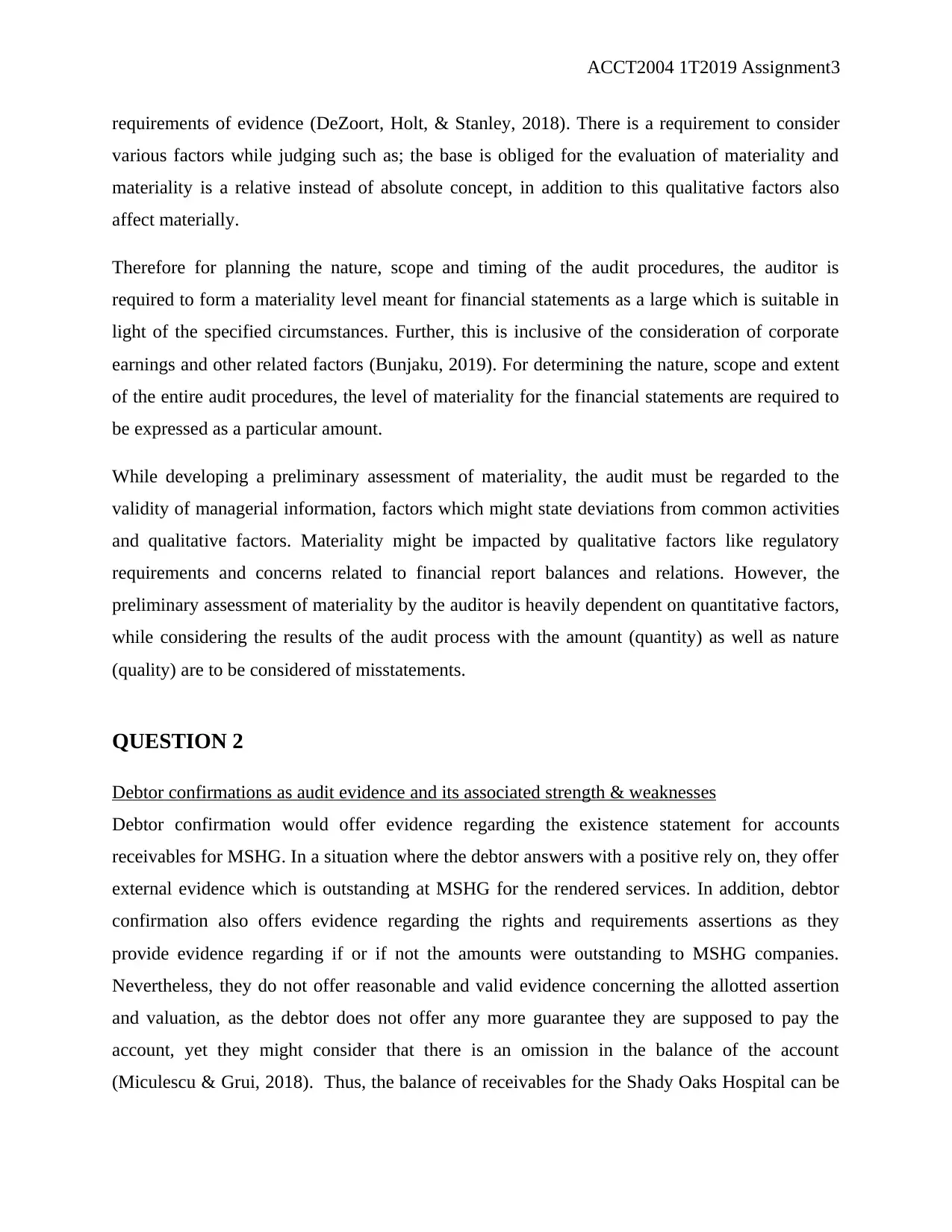
ACCT2004 1T2019 Assignment3
requirements of evidence (DeZoort, Holt, & Stanley, 2018). There is a requirement to consider
various factors while judging such as; the base is obliged for the evaluation of materiality and
materiality is a relative instead of absolute concept, in addition to this qualitative factors also
affect materially.
Therefore for planning the nature, scope and timing of the audit procedures, the auditor is
required to form a materiality level meant for financial statements as a large which is suitable in
light of the specified circumstances. Further, this is inclusive of the consideration of corporate
earnings and other related factors (Bunjaku, 2019). For determining the nature, scope and extent
of the entire audit procedures, the level of materiality for the financial statements are required to
be expressed as a particular amount.
While developing a preliminary assessment of materiality, the audit must be regarded to the
validity of managerial information, factors which might state deviations from common activities
and qualitative factors. Materiality might be impacted by qualitative factors like regulatory
requirements and concerns related to financial report balances and relations. However, the
preliminary assessment of materiality by the auditor is heavily dependent on quantitative factors,
while considering the results of the audit process with the amount (quantity) as well as nature
(quality) are to be considered of misstatements.
QUESTION 2
Debtor confirmations as audit evidence and its associated strength & weaknesses
Debtor confirmation would offer evidence regarding the existence statement for accounts
receivables for MSHG. In a situation where the debtor answers with a positive rely on, they offer
external evidence which is outstanding at MSHG for the rendered services. In addition, debtor
confirmation also offers evidence regarding the rights and requirements assertions as they
provide evidence regarding if or if not the amounts were outstanding to MSHG companies.
Nevertheless, they do not offer reasonable and valid evidence concerning the allotted assertion
and valuation, as the debtor does not offer any more guarantee they are supposed to pay the
account, yet they might consider that there is an omission in the balance of the account
(Miculescu & Grui, 2018). Thus, the balance of receivables for the Shady Oaks Hospital can be
requirements of evidence (DeZoort, Holt, & Stanley, 2018). There is a requirement to consider
various factors while judging such as; the base is obliged for the evaluation of materiality and
materiality is a relative instead of absolute concept, in addition to this qualitative factors also
affect materially.
Therefore for planning the nature, scope and timing of the audit procedures, the auditor is
required to form a materiality level meant for financial statements as a large which is suitable in
light of the specified circumstances. Further, this is inclusive of the consideration of corporate
earnings and other related factors (Bunjaku, 2019). For determining the nature, scope and extent
of the entire audit procedures, the level of materiality for the financial statements are required to
be expressed as a particular amount.
While developing a preliminary assessment of materiality, the audit must be regarded to the
validity of managerial information, factors which might state deviations from common activities
and qualitative factors. Materiality might be impacted by qualitative factors like regulatory
requirements and concerns related to financial report balances and relations. However, the
preliminary assessment of materiality by the auditor is heavily dependent on quantitative factors,
while considering the results of the audit process with the amount (quantity) as well as nature
(quality) are to be considered of misstatements.
QUESTION 2
Debtor confirmations as audit evidence and its associated strength & weaknesses
Debtor confirmation would offer evidence regarding the existence statement for accounts
receivables for MSHG. In a situation where the debtor answers with a positive rely on, they offer
external evidence which is outstanding at MSHG for the rendered services. In addition, debtor
confirmation also offers evidence regarding the rights and requirements assertions as they
provide evidence regarding if or if not the amounts were outstanding to MSHG companies.
Nevertheless, they do not offer reasonable and valid evidence concerning the allotted assertion
and valuation, as the debtor does not offer any more guarantee they are supposed to pay the
account, yet they might consider that there is an omission in the balance of the account
(Miculescu & Grui, 2018). Thus, the balance of receivables for the Shady Oaks Hospital can be
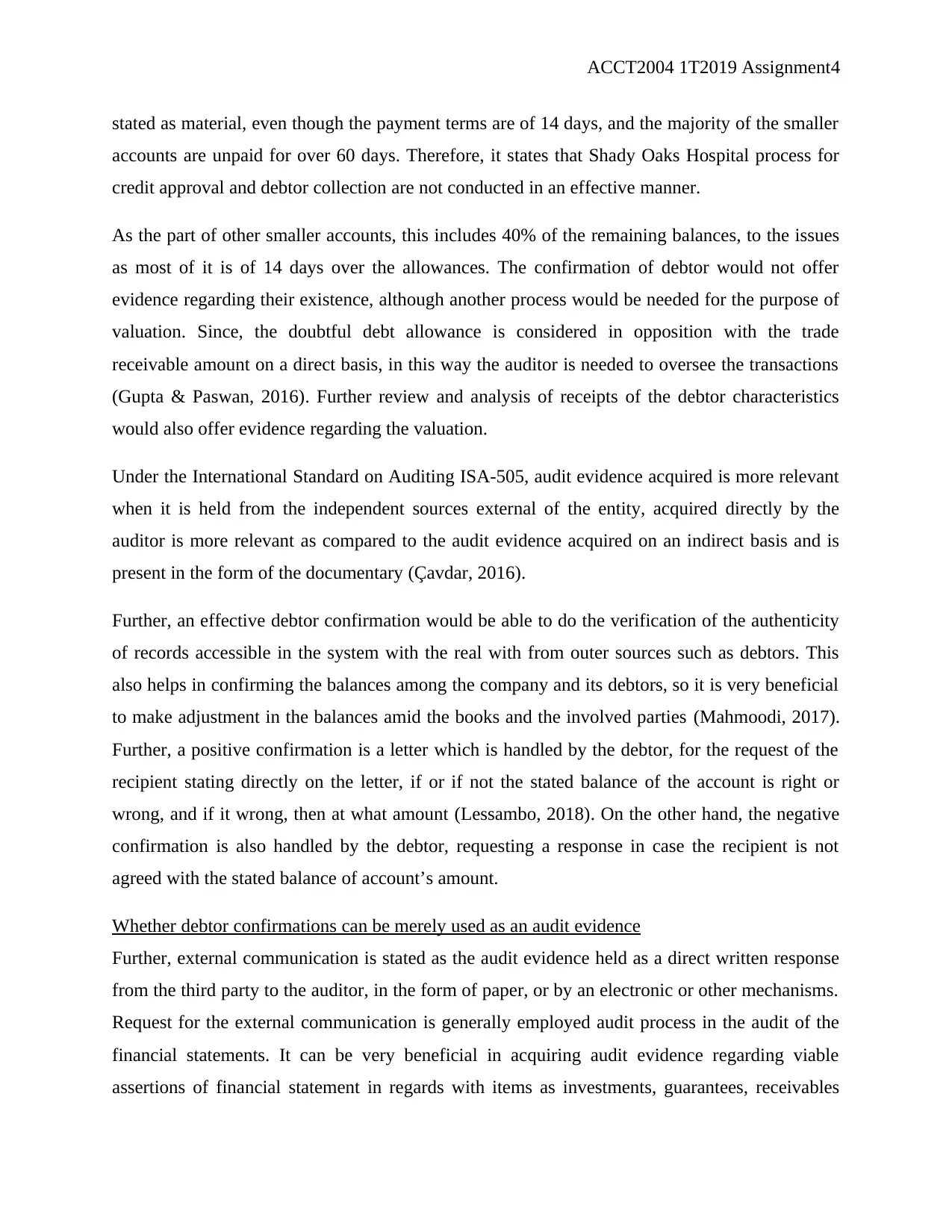
ACCT2004 1T2019 Assignment4
stated as material, even though the payment terms are of 14 days, and the majority of the smaller
accounts are unpaid for over 60 days. Therefore, it states that Shady Oaks Hospital process for
credit approval and debtor collection are not conducted in an effective manner.
As the part of other smaller accounts, this includes 40% of the remaining balances, to the issues
as most of it is of 14 days over the allowances. The confirmation of debtor would not offer
evidence regarding their existence, although another process would be needed for the purpose of
valuation. Since, the doubtful debt allowance is considered in opposition with the trade
receivable amount on a direct basis, in this way the auditor is needed to oversee the transactions
(Gupta & Paswan, 2016). Further review and analysis of receipts of the debtor characteristics
would also offer evidence regarding the valuation.
Under the International Standard on Auditing ISA-505, audit evidence acquired is more relevant
when it is held from the independent sources external of the entity, acquired directly by the
auditor is more relevant as compared to the audit evidence acquired on an indirect basis and is
present in the form of the documentary (Çavdar, 2016).
Further, an effective debtor confirmation would be able to do the verification of the authenticity
of records accessible in the system with the real with from outer sources such as debtors. This
also helps in confirming the balances among the company and its debtors, so it is very beneficial
to make adjustment in the balances amid the books and the involved parties (Mahmoodi, 2017).
Further, a positive confirmation is a letter which is handled by the debtor, for the request of the
recipient stating directly on the letter, if or if not the stated balance of the account is right or
wrong, and if it wrong, then at what amount (Lessambo, 2018). On the other hand, the negative
confirmation is also handled by the debtor, requesting a response in case the recipient is not
agreed with the stated balance of account’s amount.
Whether debtor confirmations can be merely used as an audit evidence
Further, external communication is stated as the audit evidence held as a direct written response
from the third party to the auditor, in the form of paper, or by an electronic or other mechanisms.
Request for the external communication is generally employed audit process in the audit of the
financial statements. It can be very beneficial in acquiring audit evidence regarding viable
assertions of financial statement in regards with items as investments, guarantees, receivables
stated as material, even though the payment terms are of 14 days, and the majority of the smaller
accounts are unpaid for over 60 days. Therefore, it states that Shady Oaks Hospital process for
credit approval and debtor collection are not conducted in an effective manner.
As the part of other smaller accounts, this includes 40% of the remaining balances, to the issues
as most of it is of 14 days over the allowances. The confirmation of debtor would not offer
evidence regarding their existence, although another process would be needed for the purpose of
valuation. Since, the doubtful debt allowance is considered in opposition with the trade
receivable amount on a direct basis, in this way the auditor is needed to oversee the transactions
(Gupta & Paswan, 2016). Further review and analysis of receipts of the debtor characteristics
would also offer evidence regarding the valuation.
Under the International Standard on Auditing ISA-505, audit evidence acquired is more relevant
when it is held from the independent sources external of the entity, acquired directly by the
auditor is more relevant as compared to the audit evidence acquired on an indirect basis and is
present in the form of the documentary (Çavdar, 2016).
Further, an effective debtor confirmation would be able to do the verification of the authenticity
of records accessible in the system with the real with from outer sources such as debtors. This
also helps in confirming the balances among the company and its debtors, so it is very beneficial
to make adjustment in the balances amid the books and the involved parties (Mahmoodi, 2017).
Further, a positive confirmation is a letter which is handled by the debtor, for the request of the
recipient stating directly on the letter, if or if not the stated balance of the account is right or
wrong, and if it wrong, then at what amount (Lessambo, 2018). On the other hand, the negative
confirmation is also handled by the debtor, requesting a response in case the recipient is not
agreed with the stated balance of account’s amount.
Whether debtor confirmations can be merely used as an audit evidence
Further, external communication is stated as the audit evidence held as a direct written response
from the third party to the auditor, in the form of paper, or by an electronic or other mechanisms.
Request for the external communication is generally employed audit process in the audit of the
financial statements. It can be very beneficial in acquiring audit evidence regarding viable
assertions of financial statement in regards with items as investments, guarantees, receivables
⊘ This is a preview!⊘
Do you want full access?
Subscribe today to unlock all pages.

Trusted by 1+ million students worldwide
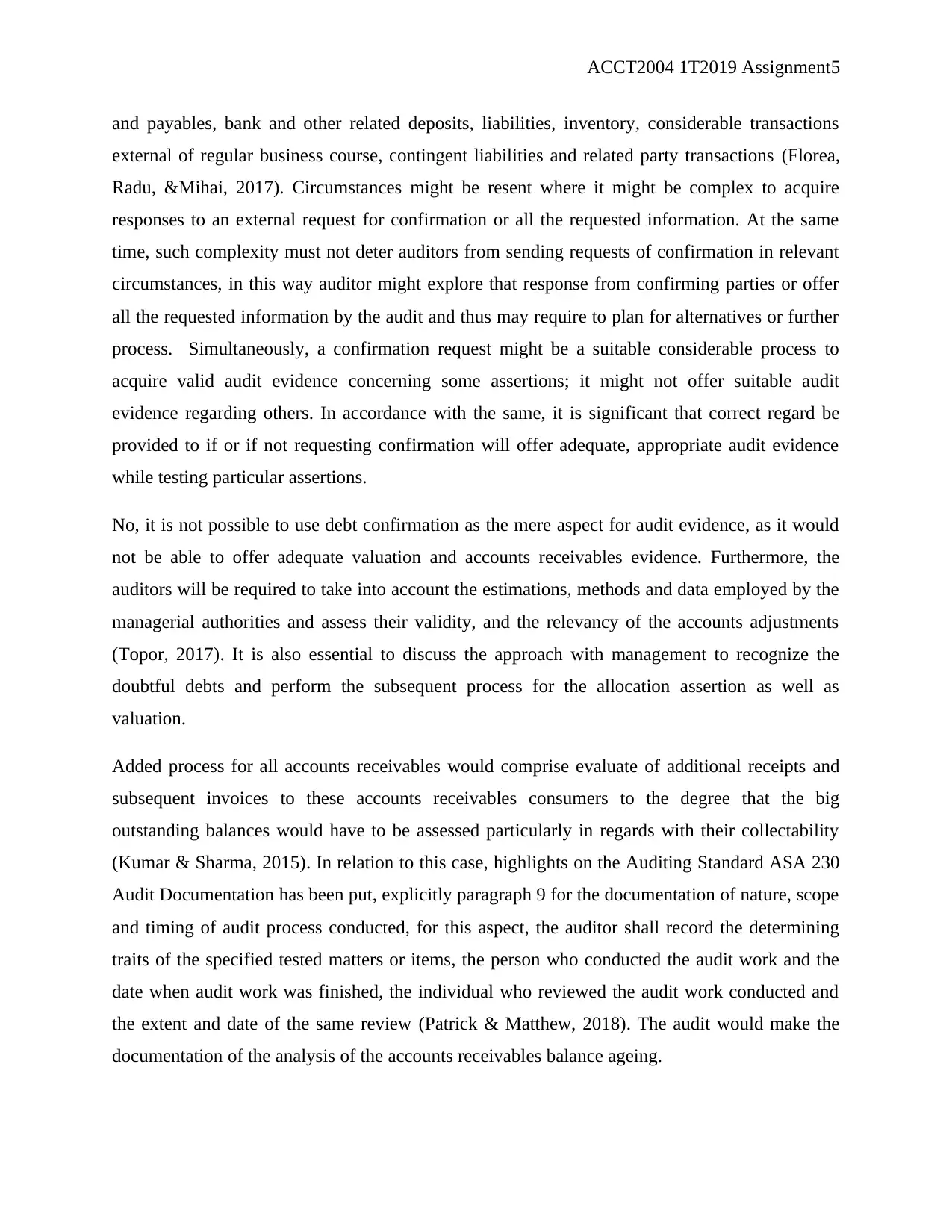
ACCT2004 1T2019 Assignment5
and payables, bank and other related deposits, liabilities, inventory, considerable transactions
external of regular business course, contingent liabilities and related party transactions (Florea,
Radu, &Mihai, 2017). Circumstances might be resent where it might be complex to acquire
responses to an external request for confirmation or all the requested information. At the same
time, such complexity must not deter auditors from sending requests of confirmation in relevant
circumstances, in this way auditor might explore that response from confirming parties or offer
all the requested information by the audit and thus may require to plan for alternatives or further
process. Simultaneously, a confirmation request might be a suitable considerable process to
acquire valid audit evidence concerning some assertions; it might not offer suitable audit
evidence regarding others. In accordance with the same, it is significant that correct regard be
provided to if or if not requesting confirmation will offer adequate, appropriate audit evidence
while testing particular assertions.
No, it is not possible to use debt confirmation as the mere aspect for audit evidence, as it would
not be able to offer adequate valuation and accounts receivables evidence. Furthermore, the
auditors will be required to take into account the estimations, methods and data employed by the
managerial authorities and assess their validity, and the relevancy of the accounts adjustments
(Topor, 2017). It is also essential to discuss the approach with management to recognize the
doubtful debts and perform the subsequent process for the allocation assertion as well as
valuation.
Added process for all accounts receivables would comprise evaluate of additional receipts and
subsequent invoices to these accounts receivables consumers to the degree that the big
outstanding balances would have to be assessed particularly in regards with their collectability
(Kumar & Sharma, 2015). In relation to this case, highlights on the Auditing Standard ASA 230
Audit Documentation has been put, explicitly paragraph 9 for the documentation of nature, scope
and timing of audit process conducted, for this aspect, the auditor shall record the determining
traits of the specified tested matters or items, the person who conducted the audit work and the
date when audit work was finished, the individual who reviewed the audit work conducted and
the extent and date of the same review (Patrick & Matthew, 2018). The audit would make the
documentation of the analysis of the accounts receivables balance ageing.
and payables, bank and other related deposits, liabilities, inventory, considerable transactions
external of regular business course, contingent liabilities and related party transactions (Florea,
Radu, &Mihai, 2017). Circumstances might be resent where it might be complex to acquire
responses to an external request for confirmation or all the requested information. At the same
time, such complexity must not deter auditors from sending requests of confirmation in relevant
circumstances, in this way auditor might explore that response from confirming parties or offer
all the requested information by the audit and thus may require to plan for alternatives or further
process. Simultaneously, a confirmation request might be a suitable considerable process to
acquire valid audit evidence concerning some assertions; it might not offer suitable audit
evidence regarding others. In accordance with the same, it is significant that correct regard be
provided to if or if not requesting confirmation will offer adequate, appropriate audit evidence
while testing particular assertions.
No, it is not possible to use debt confirmation as the mere aspect for audit evidence, as it would
not be able to offer adequate valuation and accounts receivables evidence. Furthermore, the
auditors will be required to take into account the estimations, methods and data employed by the
managerial authorities and assess their validity, and the relevancy of the accounts adjustments
(Topor, 2017). It is also essential to discuss the approach with management to recognize the
doubtful debts and perform the subsequent process for the allocation assertion as well as
valuation.
Added process for all accounts receivables would comprise evaluate of additional receipts and
subsequent invoices to these accounts receivables consumers to the degree that the big
outstanding balances would have to be assessed particularly in regards with their collectability
(Kumar & Sharma, 2015). In relation to this case, highlights on the Auditing Standard ASA 230
Audit Documentation has been put, explicitly paragraph 9 for the documentation of nature, scope
and timing of audit process conducted, for this aspect, the auditor shall record the determining
traits of the specified tested matters or items, the person who conducted the audit work and the
date when audit work was finished, the individual who reviewed the audit work conducted and
the extent and date of the same review (Patrick & Matthew, 2018). The audit would make the
documentation of the analysis of the accounts receivables balance ageing.
Paraphrase This Document
Need a fresh take? Get an instant paraphrase of this document with our AI Paraphraser
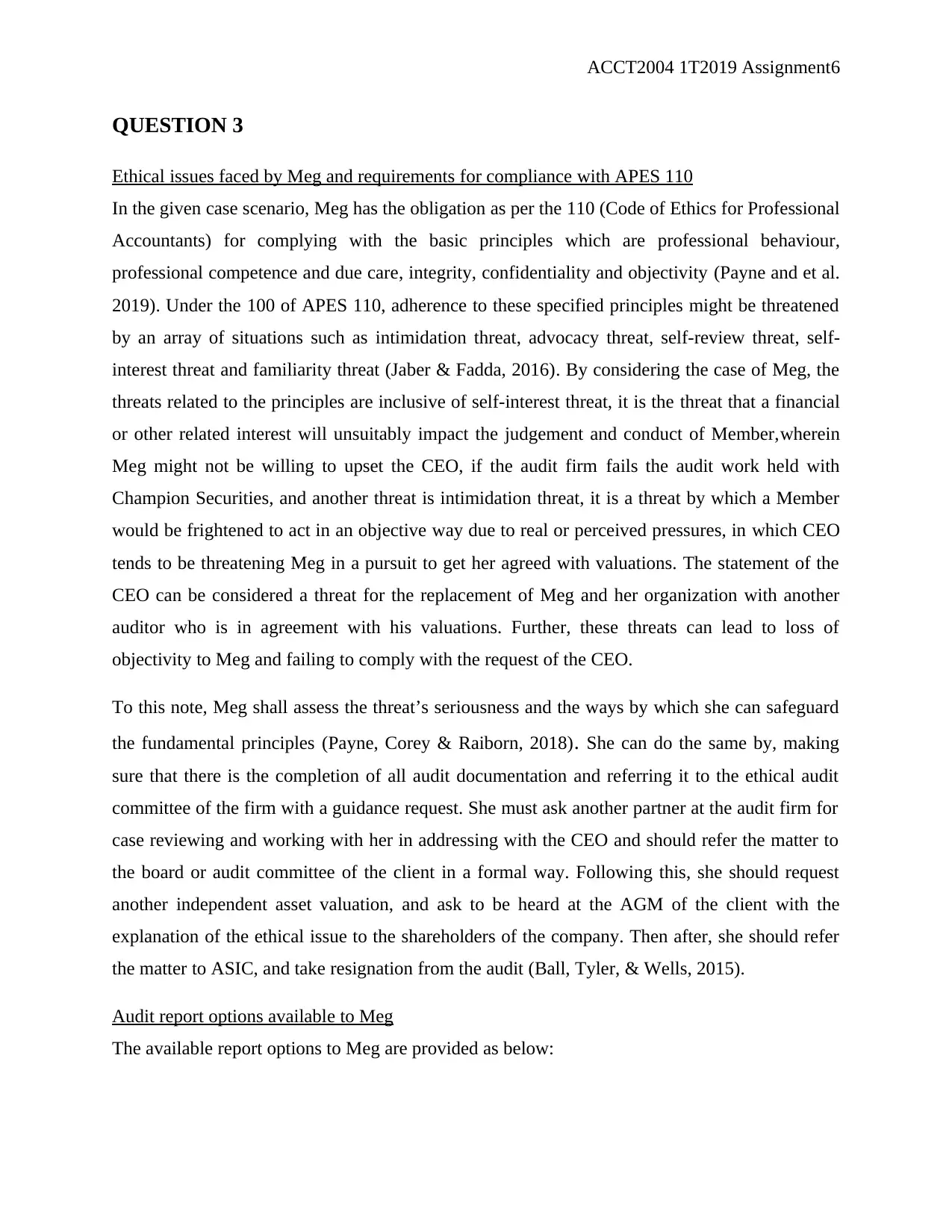
ACCT2004 1T2019 Assignment6
QUESTION 3
Ethical issues faced by Meg and requirements for compliance with APES 110
In the given case scenario, Meg has the obligation as per the 110 (Code of Ethics for Professional
Accountants) for complying with the basic principles which are professional behaviour,
professional competence and due care, integrity, confidentiality and objectivity (Payne and et al.
2019). Under the 100 of APES 110, adherence to these specified principles might be threatened
by an array of situations such as intimidation threat, advocacy threat, self-review threat, self-
interest threat and familiarity threat (Jaber & Fadda, 2016). By considering the case of Meg, the
threats related to the principles are inclusive of self-interest threat, it is the threat that a financial
or other related interest will unsuitably impact the judgement and conduct of Member,wherein
Meg might not be willing to upset the CEO, if the audit firm fails the audit work held with
Champion Securities, and another threat is intimidation threat, it is a threat by which a Member
would be frightened to act in an objective way due to real or perceived pressures, in which CEO
tends to be threatening Meg in a pursuit to get her agreed with valuations. The statement of the
CEO can be considered a threat for the replacement of Meg and her organization with another
auditor who is in agreement with his valuations. Further, these threats can lead to loss of
objectivity to Meg and failing to comply with the request of the CEO.
To this note, Meg shall assess the threat’s seriousness and the ways by which she can safeguard
the fundamental principles (Payne, Corey & Raiborn, 2018). She can do the same by, making
sure that there is the completion of all audit documentation and referring it to the ethical audit
committee of the firm with a guidance request. She must ask another partner at the audit firm for
case reviewing and working with her in addressing with the CEO and should refer the matter to
the board or audit committee of the client in a formal way. Following this, she should request
another independent asset valuation, and ask to be heard at the AGM of the client with the
explanation of the ethical issue to the shareholders of the company. Then after, she should refer
the matter to ASIC, and take resignation from the audit (Ball, Tyler, & Wells, 2015).
Audit report options available to Meg
The available report options to Meg are provided as below:
QUESTION 3
Ethical issues faced by Meg and requirements for compliance with APES 110
In the given case scenario, Meg has the obligation as per the 110 (Code of Ethics for Professional
Accountants) for complying with the basic principles which are professional behaviour,
professional competence and due care, integrity, confidentiality and objectivity (Payne and et al.
2019). Under the 100 of APES 110, adherence to these specified principles might be threatened
by an array of situations such as intimidation threat, advocacy threat, self-review threat, self-
interest threat and familiarity threat (Jaber & Fadda, 2016). By considering the case of Meg, the
threats related to the principles are inclusive of self-interest threat, it is the threat that a financial
or other related interest will unsuitably impact the judgement and conduct of Member,wherein
Meg might not be willing to upset the CEO, if the audit firm fails the audit work held with
Champion Securities, and another threat is intimidation threat, it is a threat by which a Member
would be frightened to act in an objective way due to real or perceived pressures, in which CEO
tends to be threatening Meg in a pursuit to get her agreed with valuations. The statement of the
CEO can be considered a threat for the replacement of Meg and her organization with another
auditor who is in agreement with his valuations. Further, these threats can lead to loss of
objectivity to Meg and failing to comply with the request of the CEO.
To this note, Meg shall assess the threat’s seriousness and the ways by which she can safeguard
the fundamental principles (Payne, Corey & Raiborn, 2018). She can do the same by, making
sure that there is the completion of all audit documentation and referring it to the ethical audit
committee of the firm with a guidance request. She must ask another partner at the audit firm for
case reviewing and working with her in addressing with the CEO and should refer the matter to
the board or audit committee of the client in a formal way. Following this, she should request
another independent asset valuation, and ask to be heard at the AGM of the client with the
explanation of the ethical issue to the shareholders of the company. Then after, she should refer
the matter to ASIC, and take resignation from the audit (Ball, Tyler, & Wells, 2015).
Audit report options available to Meg
The available report options to Meg are provided as below:
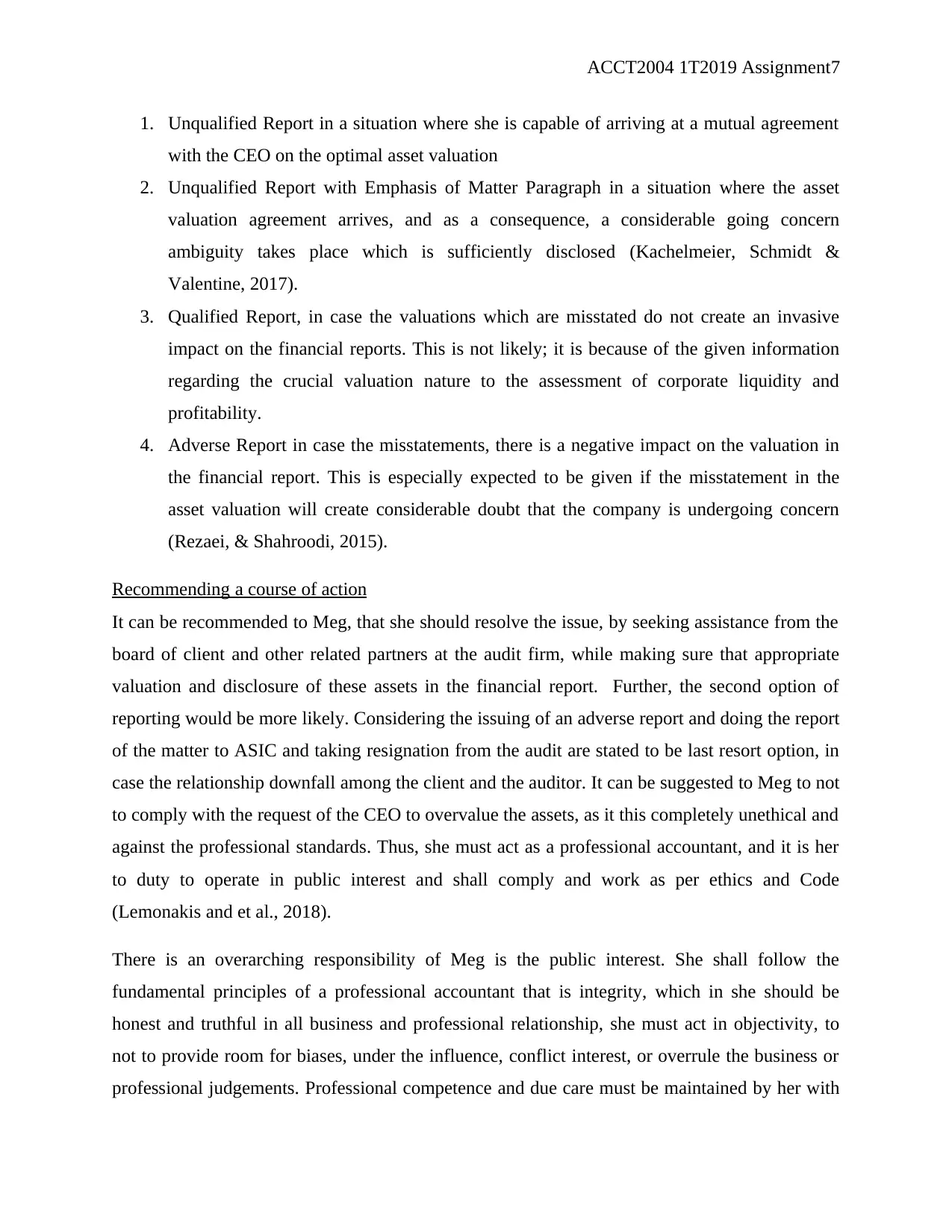
ACCT2004 1T2019 Assignment7
1. Unqualified Report in a situation where she is capable of arriving at a mutual agreement
with the CEO on the optimal asset valuation
2. Unqualified Report with Emphasis of Matter Paragraph in a situation where the asset
valuation agreement arrives, and as a consequence, a considerable going concern
ambiguity takes place which is sufficiently disclosed (Kachelmeier, Schmidt &
Valentine, 2017).
3. Qualified Report, in case the valuations which are misstated do not create an invasive
impact on the financial reports. This is not likely; it is because of the given information
regarding the crucial valuation nature to the assessment of corporate liquidity and
profitability.
4. Adverse Report in case the misstatements, there is a negative impact on the valuation in
the financial report. This is especially expected to be given if the misstatement in the
asset valuation will create considerable doubt that the company is undergoing concern
(Rezaei, & Shahroodi, 2015).
Recommending a course of action
It can be recommended to Meg, that she should resolve the issue, by seeking assistance from the
board of client and other related partners at the audit firm, while making sure that appropriate
valuation and disclosure of these assets in the financial report. Further, the second option of
reporting would be more likely. Considering the issuing of an adverse report and doing the report
of the matter to ASIC and taking resignation from the audit are stated to be last resort option, in
case the relationship downfall among the client and the auditor. It can be suggested to Meg to not
to comply with the request of the CEO to overvalue the assets, as it this completely unethical and
against the professional standards. Thus, she must act as a professional accountant, and it is her
to duty to operate in public interest and shall comply and work as per ethics and Code
(Lemonakis and et al., 2018).
There is an overarching responsibility of Meg is the public interest. She shall follow the
fundamental principles of a professional accountant that is integrity, which in she should be
honest and truthful in all business and professional relationship, she must act in objectivity, to
not to provide room for biases, under the influence, conflict interest, or overrule the business or
professional judgements. Professional competence and due care must be maintained by her with
1. Unqualified Report in a situation where she is capable of arriving at a mutual agreement
with the CEO on the optimal asset valuation
2. Unqualified Report with Emphasis of Matter Paragraph in a situation where the asset
valuation agreement arrives, and as a consequence, a considerable going concern
ambiguity takes place which is sufficiently disclosed (Kachelmeier, Schmidt &
Valentine, 2017).
3. Qualified Report, in case the valuations which are misstated do not create an invasive
impact on the financial reports. This is not likely; it is because of the given information
regarding the crucial valuation nature to the assessment of corporate liquidity and
profitability.
4. Adverse Report in case the misstatements, there is a negative impact on the valuation in
the financial report. This is especially expected to be given if the misstatement in the
asset valuation will create considerable doubt that the company is undergoing concern
(Rezaei, & Shahroodi, 2015).
Recommending a course of action
It can be recommended to Meg, that she should resolve the issue, by seeking assistance from the
board of client and other related partners at the audit firm, while making sure that appropriate
valuation and disclosure of these assets in the financial report. Further, the second option of
reporting would be more likely. Considering the issuing of an adverse report and doing the report
of the matter to ASIC and taking resignation from the audit are stated to be last resort option, in
case the relationship downfall among the client and the auditor. It can be suggested to Meg to not
to comply with the request of the CEO to overvalue the assets, as it this completely unethical and
against the professional standards. Thus, she must act as a professional accountant, and it is her
to duty to operate in public interest and shall comply and work as per ethics and Code
(Lemonakis and et al., 2018).
There is an overarching responsibility of Meg is the public interest. She shall follow the
fundamental principles of a professional accountant that is integrity, which in she should be
honest and truthful in all business and professional relationship, she must act in objectivity, to
not to provide room for biases, under the influence, conflict interest, or overrule the business or
professional judgements. Professional competence and due care must be maintained by her with
⊘ This is a preview!⊘
Do you want full access?
Subscribe today to unlock all pages.

Trusted by 1+ million students worldwide
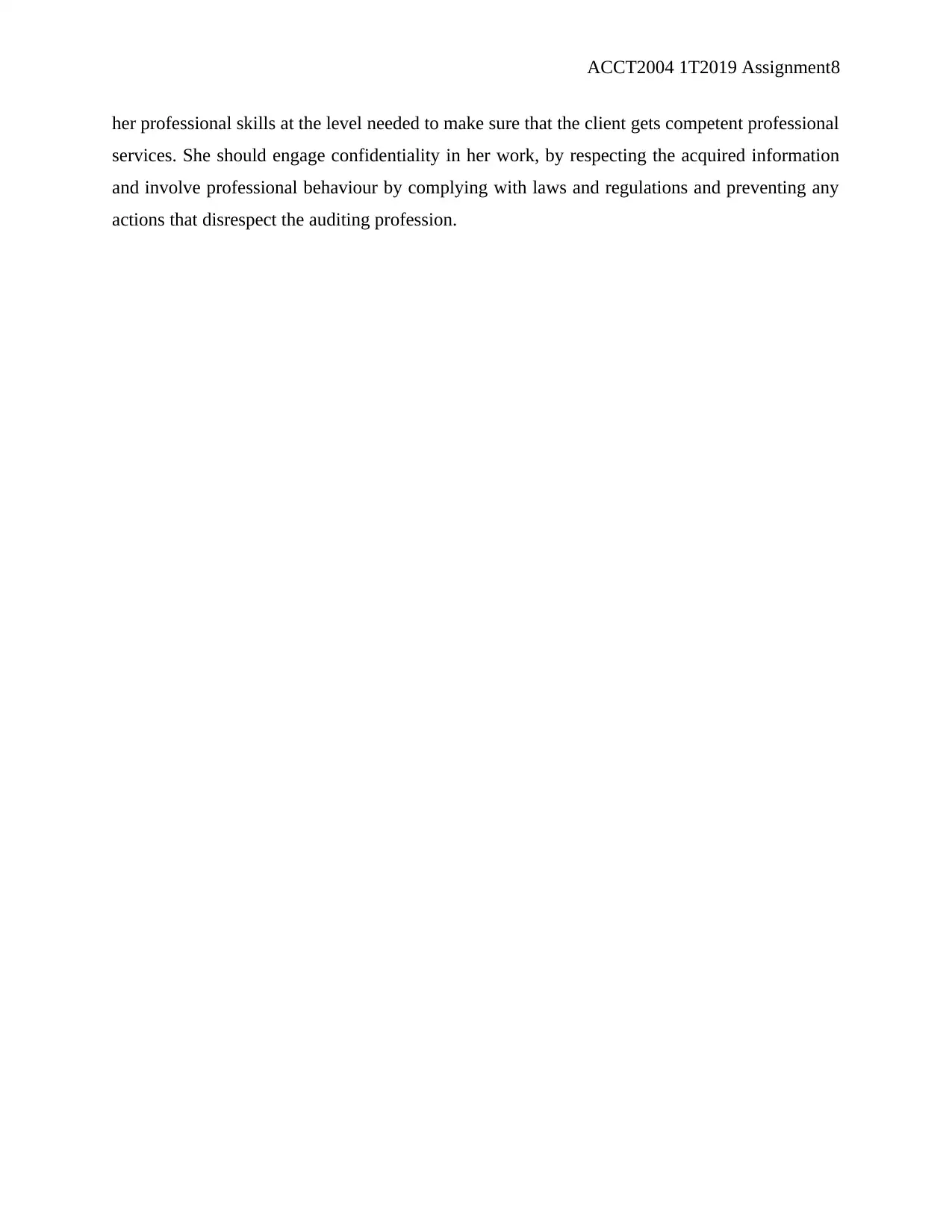
ACCT2004 1T2019 Assignment8
her professional skills at the level needed to make sure that the client gets competent professional
services. She should engage confidentiality in her work, by respecting the acquired information
and involve professional behaviour by complying with laws and regulations and preventing any
actions that disrespect the auditing profession.
her professional skills at the level needed to make sure that the client gets competent professional
services. She should engage confidentiality in her work, by respecting the acquired information
and involve professional behaviour by complying with laws and regulations and preventing any
actions that disrespect the auditing profession.
Paraphrase This Document
Need a fresh take? Get an instant paraphrase of this document with our AI Paraphraser
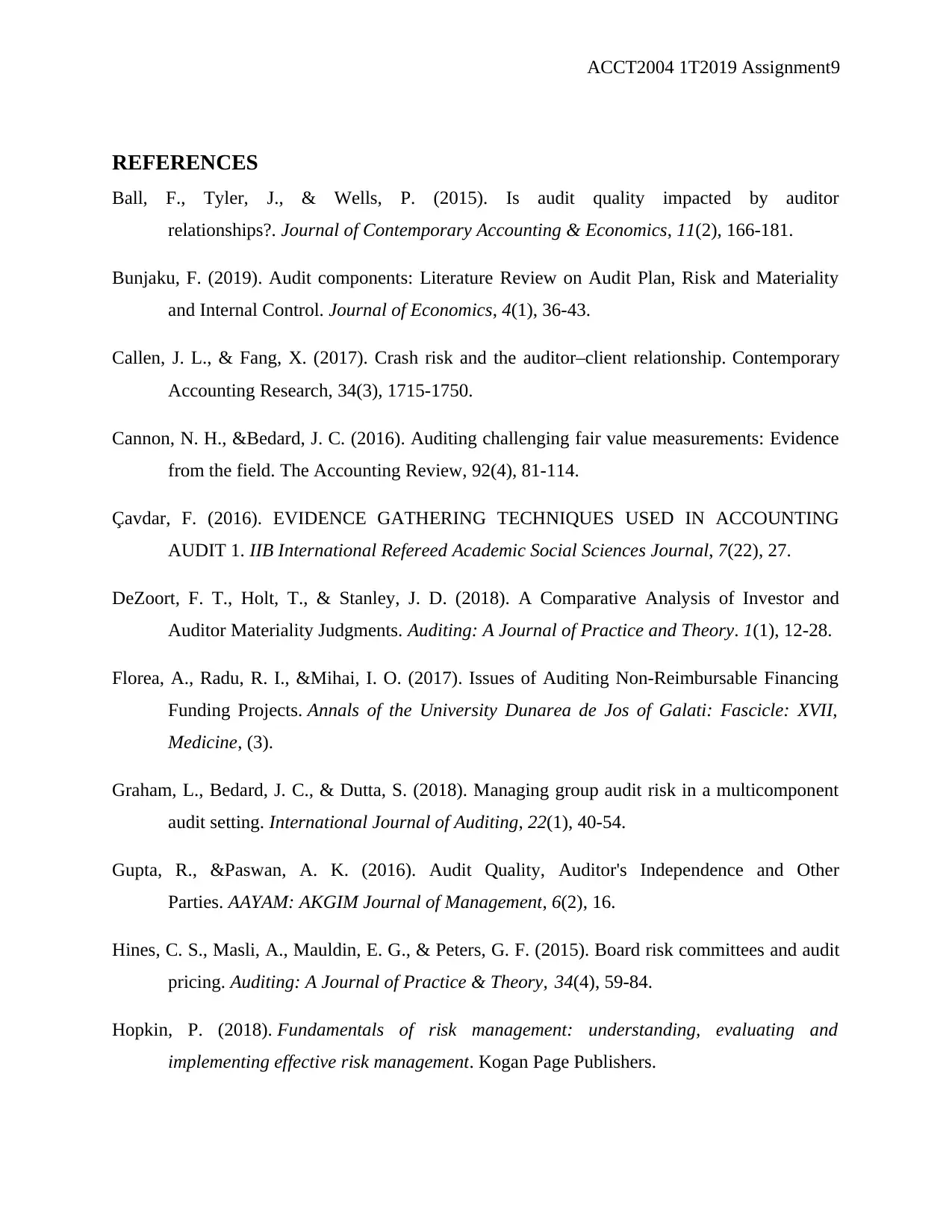
ACCT2004 1T2019 Assignment9
REFERENCES
Ball, F., Tyler, J., & Wells, P. (2015). Is audit quality impacted by auditor
relationships?. Journal of Contemporary Accounting & Economics, 11(2), 166-181.
Bunjaku, F. (2019). Audit components: Literature Review on Audit Plan, Risk and Materiality
and Internal Control. Journal of Economics, 4(1), 36-43.
Callen, J. L., & Fang, X. (2017). Crash risk and the auditor–client relationship. Contemporary
Accounting Research, 34(3), 1715-1750.
Cannon, N. H., &Bedard, J. C. (2016). Auditing challenging fair value measurements: Evidence
from the field. The Accounting Review, 92(4), 81-114.
Çavdar, F. (2016). EVIDENCE GATHERING TECHNIQUES USED IN ACCOUNTING
AUDIT 1. IIB International Refereed Academic Social Sciences Journal, 7(22), 27.
DeZoort, F. T., Holt, T., & Stanley, J. D. (2018). A Comparative Analysis of Investor and
Auditor Materiality Judgments. Auditing: A Journal of Practice and Theory. 1(1), 12-28.
Florea, A., Radu, R. I., &Mihai, I. O. (2017). Issues of Auditing Non-Reimbursable Financing
Funding Projects. Annals of the University Dunarea de Jos of Galati: Fascicle: XVII,
Medicine, (3).
Graham, L., Bedard, J. C., & Dutta, S. (2018). Managing group audit risk in a multicomponent
audit setting. International Journal of Auditing, 22(1), 40-54.
Gupta, R., &Paswan, A. K. (2016). Audit Quality, Auditor's Independence and Other
Parties. AAYAM: AKGIM Journal of Management, 6(2), 16.
Hines, C. S., Masli, A., Mauldin, E. G., & Peters, G. F. (2015). Board risk committees and audit
pricing. Auditing: A Journal of Practice & Theory, 34(4), 59-84.
Hopkin, P. (2018). Fundamentals of risk management: understanding, evaluating and
implementing effective risk management. Kogan Page Publishers.
REFERENCES
Ball, F., Tyler, J., & Wells, P. (2015). Is audit quality impacted by auditor
relationships?. Journal of Contemporary Accounting & Economics, 11(2), 166-181.
Bunjaku, F. (2019). Audit components: Literature Review on Audit Plan, Risk and Materiality
and Internal Control. Journal of Economics, 4(1), 36-43.
Callen, J. L., & Fang, X. (2017). Crash risk and the auditor–client relationship. Contemporary
Accounting Research, 34(3), 1715-1750.
Cannon, N. H., &Bedard, J. C. (2016). Auditing challenging fair value measurements: Evidence
from the field. The Accounting Review, 92(4), 81-114.
Çavdar, F. (2016). EVIDENCE GATHERING TECHNIQUES USED IN ACCOUNTING
AUDIT 1. IIB International Refereed Academic Social Sciences Journal, 7(22), 27.
DeZoort, F. T., Holt, T., & Stanley, J. D. (2018). A Comparative Analysis of Investor and
Auditor Materiality Judgments. Auditing: A Journal of Practice and Theory. 1(1), 12-28.
Florea, A., Radu, R. I., &Mihai, I. O. (2017). Issues of Auditing Non-Reimbursable Financing
Funding Projects. Annals of the University Dunarea de Jos of Galati: Fascicle: XVII,
Medicine, (3).
Graham, L., Bedard, J. C., & Dutta, S. (2018). Managing group audit risk in a multicomponent
audit setting. International Journal of Auditing, 22(1), 40-54.
Gupta, R., &Paswan, A. K. (2016). Audit Quality, Auditor's Independence and Other
Parties. AAYAM: AKGIM Journal of Management, 6(2), 16.
Hines, C. S., Masli, A., Mauldin, E. G., & Peters, G. F. (2015). Board risk committees and audit
pricing. Auditing: A Journal of Practice & Theory, 34(4), 59-84.
Hopkin, P. (2018). Fundamentals of risk management: understanding, evaluating and
implementing effective risk management. Kogan Page Publishers.
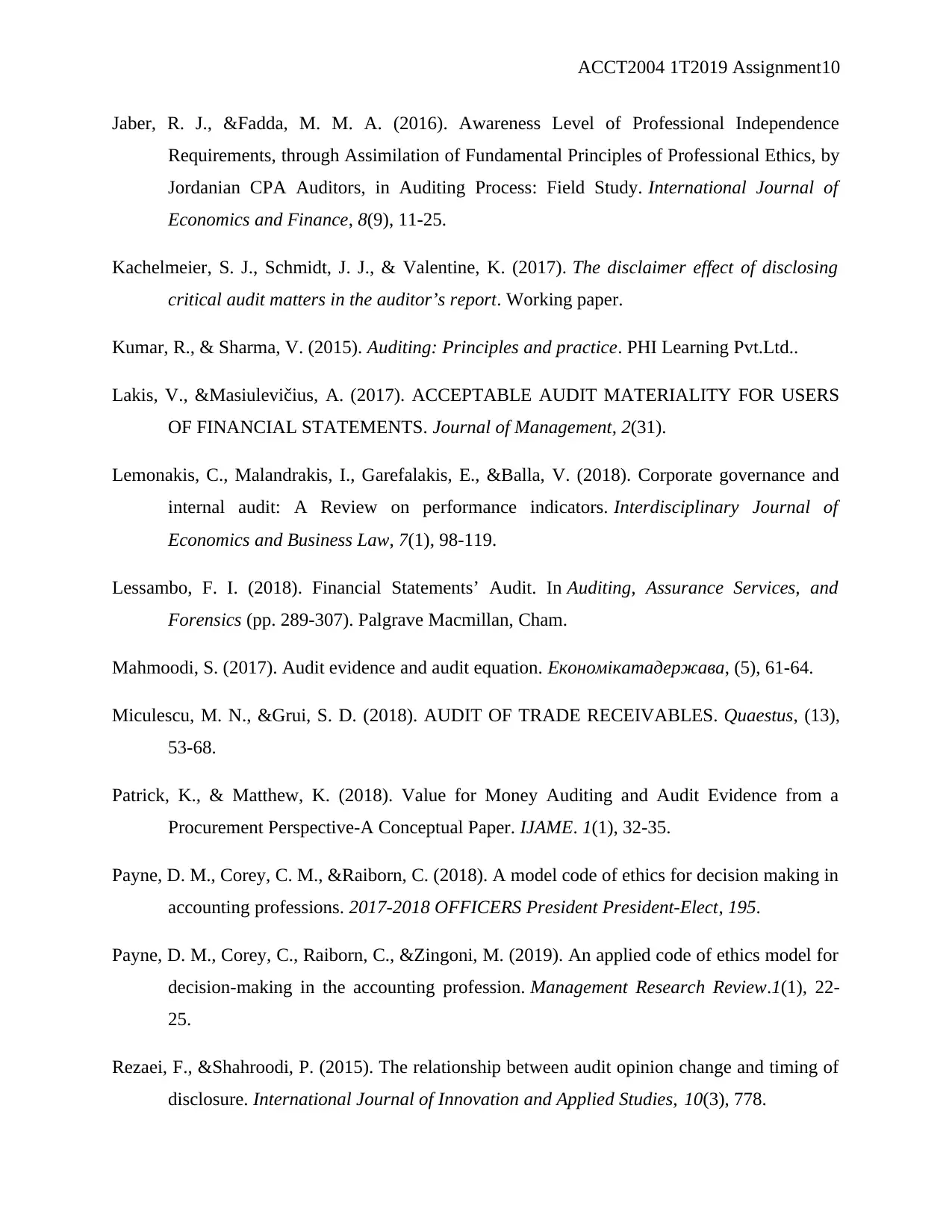
ACCT2004 1T2019 Assignment10
Jaber, R. J., &Fadda, M. M. A. (2016). Awareness Level of Professional Independence
Requirements, through Assimilation of Fundamental Principles of Professional Ethics, by
Jordanian CPA Auditors, in Auditing Process: Field Study. International Journal of
Economics and Finance, 8(9), 11-25.
Kachelmeier, S. J., Schmidt, J. J., & Valentine, K. (2017). The disclaimer effect of disclosing
critical audit matters in the auditor’s report. Working paper.
Kumar, R., & Sharma, V. (2015). Auditing: Principles and practice. PHI Learning Pvt.Ltd..
Lakis, V., &Masiulevičius, A. (2017). ACCEPTABLE AUDIT MATERIALITY FOR USERS
OF FINANCIAL STATEMENTS. Journal of Management, 2(31).
Lemonakis, C., Malandrakis, I., Garefalakis, E., &Balla, V. (2018). Corporate governance and
internal audit: A Review on performance indicators. Interdisciplinary Journal of
Economics and Business Law, 7(1), 98-119.
Lessambo, F. I. (2018). Financial Statements’ Audit. In Auditing, Assurance Services, and
Forensics (pp. 289-307). Palgrave Macmillan, Cham.
Mahmoodi, S. (2017). Audit evidence and audit equation. Економікатадержава, (5), 61-64.
Miculescu, M. N., &Grui, S. D. (2018). AUDIT OF TRADE RECEIVABLES. Quaestus, (13),
53-68.
Patrick, K., & Matthew, K. (2018). Value for Money Auditing and Audit Evidence from a
Procurement Perspective-A Conceptual Paper. IJAME. 1(1), 32-35.
Payne, D. M., Corey, C. M., &Raiborn, C. (2018). A model code of ethics for decision making in
accounting professions. 2017-2018 OFFICERS President President-Elect, 195.
Payne, D. M., Corey, C., Raiborn, C., &Zingoni, M. (2019). An applied code of ethics model for
decision-making in the accounting profession. Management Research Review.1(1), 22-
25.
Rezaei, F., &Shahroodi, P. (2015). The relationship between audit opinion change and timing of
disclosure. International Journal of Innovation and Applied Studies, 10(3), 778.
Jaber, R. J., &Fadda, M. M. A. (2016). Awareness Level of Professional Independence
Requirements, through Assimilation of Fundamental Principles of Professional Ethics, by
Jordanian CPA Auditors, in Auditing Process: Field Study. International Journal of
Economics and Finance, 8(9), 11-25.
Kachelmeier, S. J., Schmidt, J. J., & Valentine, K. (2017). The disclaimer effect of disclosing
critical audit matters in the auditor’s report. Working paper.
Kumar, R., & Sharma, V. (2015). Auditing: Principles and practice. PHI Learning Pvt.Ltd..
Lakis, V., &Masiulevičius, A. (2017). ACCEPTABLE AUDIT MATERIALITY FOR USERS
OF FINANCIAL STATEMENTS. Journal of Management, 2(31).
Lemonakis, C., Malandrakis, I., Garefalakis, E., &Balla, V. (2018). Corporate governance and
internal audit: A Review on performance indicators. Interdisciplinary Journal of
Economics and Business Law, 7(1), 98-119.
Lessambo, F. I. (2018). Financial Statements’ Audit. In Auditing, Assurance Services, and
Forensics (pp. 289-307). Palgrave Macmillan, Cham.
Mahmoodi, S. (2017). Audit evidence and audit equation. Економікатадержава, (5), 61-64.
Miculescu, M. N., &Grui, S. D. (2018). AUDIT OF TRADE RECEIVABLES. Quaestus, (13),
53-68.
Patrick, K., & Matthew, K. (2018). Value for Money Auditing and Audit Evidence from a
Procurement Perspective-A Conceptual Paper. IJAME. 1(1), 32-35.
Payne, D. M., Corey, C. M., &Raiborn, C. (2018). A model code of ethics for decision making in
accounting professions. 2017-2018 OFFICERS President President-Elect, 195.
Payne, D. M., Corey, C., Raiborn, C., &Zingoni, M. (2019). An applied code of ethics model for
decision-making in the accounting profession. Management Research Review.1(1), 22-
25.
Rezaei, F., &Shahroodi, P. (2015). The relationship between audit opinion change and timing of
disclosure. International Journal of Innovation and Applied Studies, 10(3), 778.
⊘ This is a preview!⊘
Do you want full access?
Subscribe today to unlock all pages.

Trusted by 1+ million students worldwide
1 out of 13
Related Documents
Your All-in-One AI-Powered Toolkit for Academic Success.
+13062052269
info@desklib.com
Available 24*7 on WhatsApp / Email
![[object Object]](/_next/static/media/star-bottom.7253800d.svg)
Unlock your academic potential
Copyright © 2020–2025 A2Z Services. All Rights Reserved. Developed and managed by ZUCOL.





